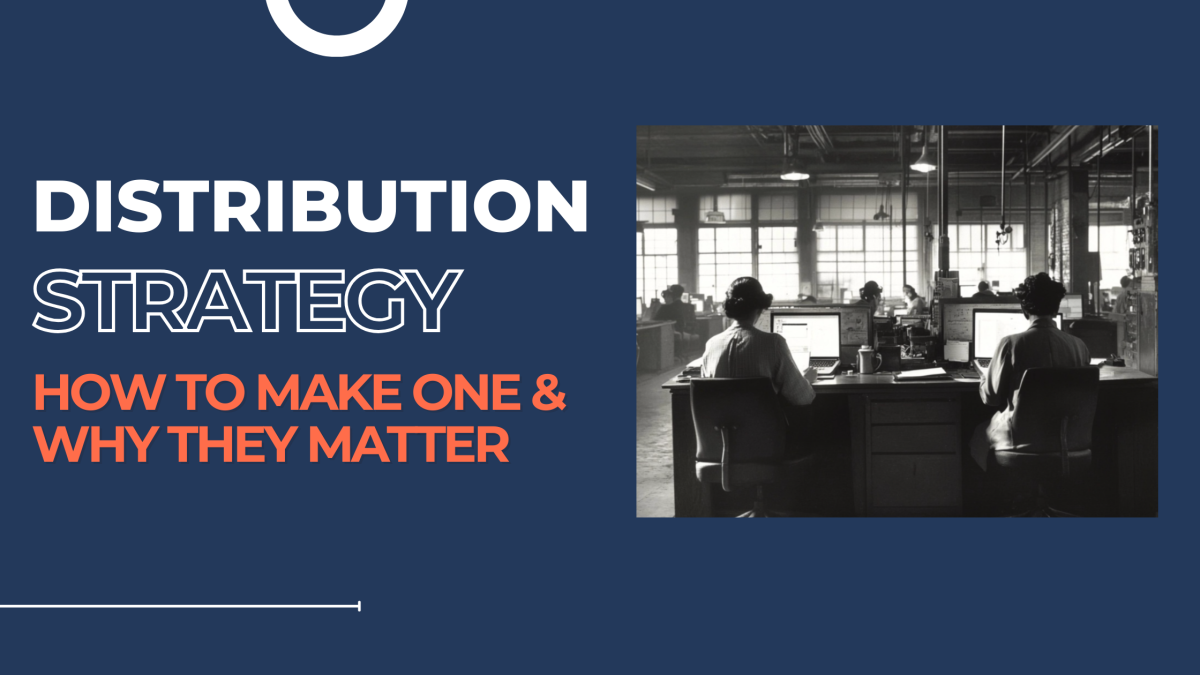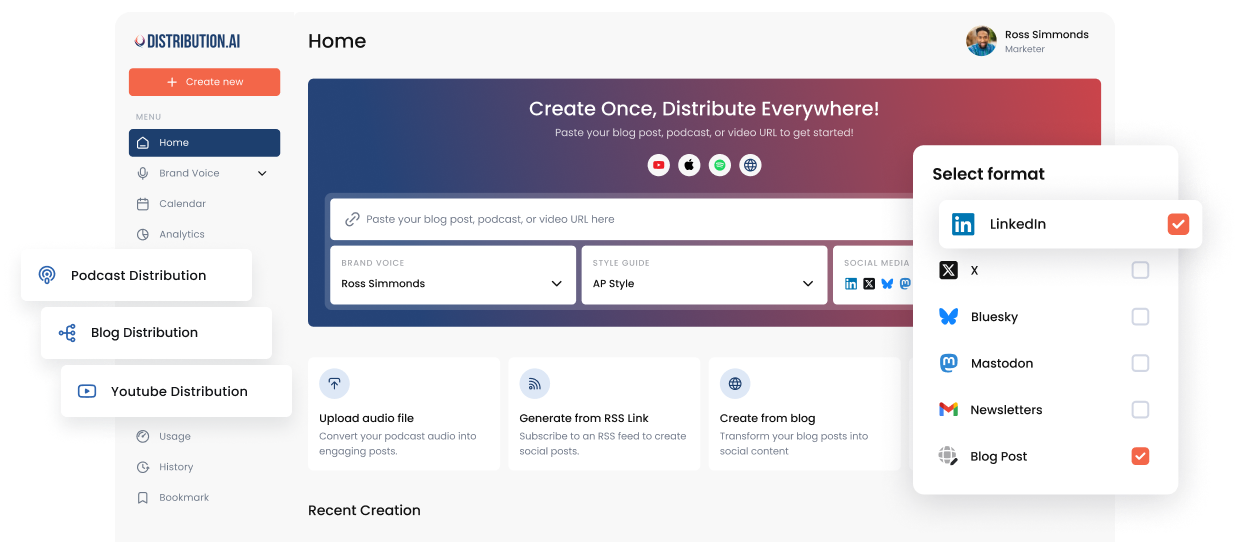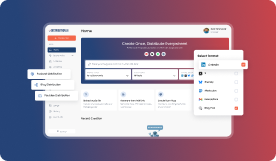How to Build an Effective Distribution Strategy (With Real Examples + Best Practices)
Learn how to build an effective distribution strategy, choose the right channels, and reach your target market with actionable steps and real-life examples.

What Is a Distribution Strategy in Marketing?
A distribution strategy is a plan that outlines how your product or service moves from production to the hands of your customer. In other words, distribution is about making products available to customers in the most direct and cost-effective way, either through direct channels or via intermediary businesses.
A smart distribution strategy ensures your product reaches customers where they expect to buy it, while balancing margins, operations, brand experience, and scalability. It involves decisions such as:
- Should we sell directly or use intermediaries?
- How many levels of distribution (wholesaler, retailer, agent)?
- Which geographic areas and channels to prioritize?
- How to manage logistics, inventory, returns, and partner relationships?
A distribution strategy defines how your product reaches its target market. Without a clear, well-planned system, even great products can miss their customers—and that directly impacts sales and revenue.
Types of Product Distribution Strategy
The distribution channel strategy determines how your product reaches its target market— through your own stores or via wholesalers and retailers.
When choosing your distribution method, there’s no one-size-fits-all approach. The right one depends on your product type, target audience, and business objectives. Below are the main types of distribution strategies used in marketing.
Intensive distribution strategy
An intensive distribution strategy focuses on placing your product in as many outlets as possible to maximize visibility and reach. The goal is to make your product available wherever customers might look for it.
When to use:
Use this when you’re selling high-volume, low-cost items that rely on convenience and impulse buying, such as beverages, snacks, household goods, or personal care products. You want to reach consumers through multiple distribution channels like supermarkets, grocery stores, gas stations, and department stores.
Example:
Lay’s, by PepsiCo, uses an intensive distribution approach. You’ll find its chips in grocery stores, vending machines, gas stations, and online marketplaces. The brand relies on high visibility and impulse purchases to expand its customer base and keep sales volume up.
Selective distribution strategy
A selective distribution strategy means choosing a limited number of retail partners or outlets to sell your product. It strikes a balance between wide availability and maintaining brand control.
When to use:
Use this when your brand needs a mix of reach and reputation. Typically suited for mid-range products like consumer electronics, furniture, or home appliances. It works best when your sales depend on customer assistance or in-store experience.
Example:
Sony follows a selective distribution approach. Its products are available in authorized electronic stores and select online marketplaces, not in every retail outlet. This helps maintain brand value while ensuring sufficient reach.
Exclusive distribution strategy
An exclusive distribution strategy limits your product availability to a single distributor or retailer per territory. This gives you maximum control over brand image, pricing, and customer experience.
When to use:
Use this strategy for premium, luxury, or niche products where exclusivity enhances perceived value. It’s ideal for brands that rely on a high-touch customer experience and want to maintain tight control over quality and reputation.
Example:
Rolex uses an exclusive distribution strategy, selling only through carefully chosen, authorized retailers. This controlled availability reinforces its luxury positioning and builds long-term brand loyalty.
Direct distribution strategy
A direct distribution strategy involves selling products directly to the end consumer without intermediaries. In this strategy, the company owns the sales channel, be it an e-commerce website, physical stores, or a direct sales team.
When to use:
Use this when you want more control over customer experience, pricing, and data. It’s suitable for brands that can manage logistics independently or operate digitally (like B2B and D2C brands).
Example:
D2C brands like Warby Parker, an eyewear brand, follow a direct distribution model. It sells through its own stores and online platform.
Similarly, B2B (SaaS) platforms like Distribution AI also use a direct distribution strategy. The all-in-one content repurposing platform reaches its target market—agencies, content creators, social media managers—directly through organic marketing and outbound sales, instead of marketplaces.

Indirect distribution strategy
An indirect distribution strategy uses intermediaries such as wholesalers, resellers, or retail partners to deliver products to the end consumer. This approach expands reach without the company managing every step of the supply chain.
When to use:
Use this when your priority is scaling or reaching markets where direct distribution operations aren’t feasible. It’s a common strategy for consumer goods, FMCG, and global brands that rely on retail networks or distributors.
Example:
Unilever uses an indirect distribution model. Its products flow through a network of distributors and retailers—from supermarkets to convenience stores—ensuring global coverage with local presence.
Hybrid or dual distribution strategy
A hybrid distribution strategy combines direct and indirect distribution channels. The company sells through its own stores or website while also working with partners and retailers.
When to use:
Use this when you want to expand market reach but still retain some control over customer relationships. It’s best for established brands that operate both online and offline.
Example:
Apple uses a hybrid distribution strategy—selling through multiple distribution channels like its own retail stores and e-commerce site while also partnering with selected resellers. This ensures both visibility and consistency in the customer experience.
Why is Distribution Strategy Critical?
You might make the best product in the world, but without a solid distribution strategy, it may never reach profitability. That’s why distribution is an important part of a company’s marketing strategy. Here’s why you should have a well-planned distribution system:
Helps penetrate the market and reach your audience
A strong distribution strategy ensures your product is available exactly where your customers shop—be it online, in specialty stores, or via partners. Without it, your offering risks invisibility, no matter how good it is.
For example, Segway’s electric scooter failed for several reasons: a vague target market, product defects, high cost, and a flawed distribution strategy. The product was sold only through select dealerships, which limited accessibility for modern consumers who preferred online shopping.
Improves margins and reduces cost
Channels (transport, warehousing, margins for intermediaries) carry real costs. The wrong mix can significantly reduce your profits. So, getting strategic about which partners to use or owning parts of the supply chain lets you preserve more margin.
Quick Tip: Do a breakdown of cost per unit through a distributor vs. going direct. Even 5–10% saved per sale aggregates fast.
Creates a competitive edge
Your distribution system can become a hidden competitive advantage. If you control premium channel access, superior logistics, or exclusive access to retailers, you can reach target customers in places where your direct competitors struggle.
For example, Walgreens prioritizes store density and drive-through access as part of its distribution strategy. In many urban areas, they cluster stores tightly so that customers are never far from a location. This convenient distribution is why many people prefer Walgreens over its competitors.
Provides market insights
Whether you sell directly or through intermediaries, distribution is your best source of valuable market insights. Your distribution partners or your own sales and support teams (in a direct model) tell you what’s selling, where demand is shifting, and what objections customers raise. With such feedback loops, you can take steps to refine your strategy and service.
Suppose a distributor in a region reports consistent returns because customers cite “complex installation.” Or, if you sell directly, your support team flags repeated setup issues. Either way, that insight helps you refine your product or training before more losses pile up.
How to Create an Effective Distribution Strategy?
Building a distribution strategy requires step-by-step planning. Here’s how you can create one with clarity and purpose.
Step 1: Define your target market and understand buying behavior
Start by identifying who your customers are and how they buy. Segment them by location, purchase frequency, and preferred buying channels — retail stores, e-commerce websites, or direct sales.
Study where your existing sales are coming from and where untapped demand lies. If you’re in B2B, map the decision-making chain: Who influences, who buys, and how long it takes.
For example, a consumer electronics brand might find that most of its younger audience prefers online shopping, while business buyers still prefer in-store demos or authorized resellers. Adjusting your distribution channels or using a hybrid strategy will help reach both segments effectively.
Step 2: Align distribution with overall business objectives
Your distribution strategy should directly support your company’s specific growth objectives. Whether you want faster market reach, higher margins, or tighter brand control, the channels you choose should reflect that.
For example, selective distribution (using a few high-quality outlets) is for premium brands that prioritize tighter control over brand image and pricing. On the other hand, intensive distribution across multiple channels works well for high-volume brands whose goal is to scale.
Step 3: Choose and prioritize the right channels
Evaluate each potential channel—direct, indirect, or hybrid—based on business model, product type, cost, control, scalability, and customer experience. Avoid spreading resources across every option. When considering which channels to pursue, it’s also crucial to think about how you’re designing your products to fit those channels as it can streamline logistics, improve shelf appeal, and ensure compatibility with various retail or digital platforms.
While direct distribution offers more control and customer data, indirect channels provide reach through distribution partners or retail partners. Many brands now adopt dual/hybrid distribution to reach different customer segments and also control the distribution system better.
For example, smartphone companies like Samsung sell flagship devices (like Galaxy S and Fold series) through exclusive retail partners while offering accessories and mid-range products via online marketplaces.
Step 4: Build strong partner relationships
If you rely on intermediaries, treat them as extensions of your brand. Choose partners that align with your positioning and can meet service expectations.
- Set clear margins, responsibilities, and performance metrics.
- Support them with co-marketing funds, product training, and consistent communication.
If you sell via direct distribution channels, build this same structure around your direct sales teams or in-store staff.
- Train them to act as brand ambassadors
- Ensure clear communication between teams.
- Close the feedback loop between customers and operations.
Step 5: Optimize your supply chain and logistics
Set up a supply chain management and reverse distribution system that ensures fast delivery, minimal stockouts, and smooth returns.
- Position inventory closer to key markets to shorten delivery times and lower shipping costs. Use regional fulfillment centers or partner warehouses.
- Automate reorders based on real-time demand data to avoid stockouts and overstocking.
- Diversify logistics partners so you’re not dependent on one carrier — this ensures continuity during disruptions.
- Integrate systems (sales, warehouse, and logistics) to keep visibility across all distribution channels.
- Plan for a fast return process, repairs, exchange, or recycling to improve customer satisfaction.
- Monitor delivery KPIs like on-time performance, fulfillment cost per order, and average return time, and adjust routes, partners, or warehouses based on data.
Step 6: Measure and iterate based on data
Once your channels are live, monitor key metrics like channel ROI, fulfillment time, and customer feedback. Track which distribution methods perform best and which underdeliver.
Run small experiments — test pricing incentives, delivery speed, or packaging — and adjust your approach. A strong distribution strategy evolves with customer expectations and market trends.
For example, a beverage company might start with supermarket sales to increase brand awareness, then test direct subscriptions through its website once it grows. The data will guide whether to expand or double down on the direct model.
5 Common Distribution Challenges & Their Solutions
Even the most well-planned distribution strategy faces real-world hurdles once it’s in motion. From channel conflicts to delivery issues, these challenges can quietly erode efficiency if not managed early.
Channel conflict between direct and indirect channels
The direct vs. indirect channels conflict is a common issue in distribution. Back in the day, even Nike faced this challenge while expanding its sales and distribution network.
When a brand sells directly through its own website and through distributors or retail partners, it can accidentally compete with them. For example, if your online store sells the same product at a lower price, your retail partners may feel undercut and less motivated to promote your brand. This is called channel conflict, which often arises when companies add new direct sales channels without balancing them with existing ones.
Best practices:
- Use unified pricing across channels, or clearly differentiate SKUs for direct vs partner channels.
- Offer exclusive products, bundles, or features only through your direct channel so partners don’t feel bypassed.
- Negotiate contractual protections like minimum margins, geographic exclusivity, or SOPs preventing cross-territory sales.
- Share forecasts and inventory levels with partners so they understand your direct plans ahead of time.
Underperforming channel partners
Partners often lose interest in promoting your product when the margins are too low or when what drives their profits doesn’t match what drives your growth. If they earn more by selling competing products, your line naturally gets deprioritized. Misaligned expectations, unclear targets, or a lack of support can quickly turn even good distributors into passive ones.
Best practices:
- Structure a tiered incentive system with higher margins, bonuses, or marketing funds for hitting volume thresholds.
- Provide partner enablement, such as training kits, sales collateral, demo units, and fast support.
- Hold regular performance reviews and joint business planning sessions.
- Use shared dashboards so both you and your partners see real-time metrics, such as sales, returns, and growth. This builds alignment, collaboration, and trust.
Inventory gaps and stockouts
When products sit in the wrong place or run out altogether, customers lose trust fast. Stockouts, poor forecasting, and over-centralized inventory waste time, capital, and opportunity. It’s a classic supply chain issue that can quietly eat into both sales and reputation.
Best Practices:
- Use demand-driven forecasting and safety stock calculations per geography.
- Decentralize inventory: create regional fulfillment centers or partner warehouses closer to demand centers.
- Automate reorder triggers and monitor lead times to avoid delays.
- Use data analytics to spot slow-moving SKUs and reallocate before stockouts spiral.
Slow deliveries due to logistics disruptions
Delays in shipping, inefficient routing, or relying too heavily on one logistics provider can quickly break trust and hamper customer loyalty. When deliveries take longer than promised or orders go missing, even loyal buyers start looking elsewhere.
Best practices:
- Use multiple logistics partners (a mix of local, national, and specialty carriers) to mitigate risk.
- Monitor delivery KPIs (on-time rate, damage rate, last-mile cost).
- Use route optimization software or third-party logistics with strong SLAs.
- Build flexibility into the system: buffer capacity during peak seasons, plan backup routes, and maintain safety stock.
Lack of market feedback and visibility
In large distribution networks, companies lose direct contact with end customers, missing insights about pain points, returns, or customer preferences. This is especially seen in indirect distribution models.
Best practices:
- Ensure partners and your direct sales/support teams take feedback and convey qualitative and quantitative insights regularly.
- Use structured feedback tools like 1–3 question post-sale surveys, field reports, and return reason codes.
- Conduct random checks in partner stores or regions to see how your products are being sold and presented. Reach out to customers directly through short surveys or follow-up calls to gather feedback about their buying experience.
- When you act on feedback (product improvements, packaging changes, training updates), share it with partners so they see value in input.
Final Note
The right distribution strategy determines who sees your product, how they experience it, and whether your business can scale profitably. Whether you pick direct, indirect, or a hybrid approach, make those choices deliberately: match channels to customer behavior, protect margins with clear rules, and measure channel performance continuously.
As more customers shift to online shopping, strengthening your digital distribution and tracking those channels becomes essential. Tools like Distribution AI can help automate outreach and measure performance so you can test channels faster and optimize where it matters.
Frequently Asked Questions
Promote, repurpose & distribute your content with AI
Start 15-Day Free Trial
